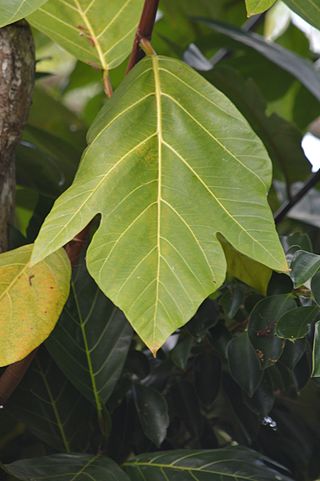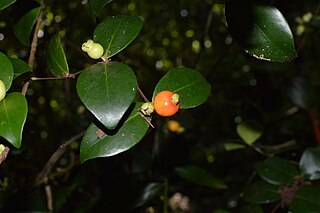
Louis Claude de Saulces de Freycinet was a French Navy officer. He circumnavigated the Earth, and in 1811 published the first map to show a full outline of the coastline of Australia.

The banded hare-wallaby, mernine, or munning is a marsupial currently found on the islands of Bernier and Dorre off western Australia. Reintroduced populations have recently been established on islands and fenced mainland sites, including Faure Island and Wadderin Sanctuary near Narembeen in the central wheatbelt.

Joseph Paul Gaimard was a French naval surgeon and naturalist.

Jean René Constant Quoy was a French naval surgeon, zoologist and anatomist.

The dusky megapode, also known as dusky scrubfowl or common megapode, is a medium-sized, approximately 41 cm long, blackish bird with a short pointed crest, bare red facial skin, dark legs, brown irises, and a dark brown and yellow bill. The male and female are similar. This terrestrial species lives in forests and swamps, including mangroves, of the Maluku and Raja Ampat Islands in Indonesia. Like other megapodes, it lays its eggs in a mound made from earth mixed with leaves, sand, gravel, and sticks, which can be as large as 11 m (36 ft) in diameter and stand nearly 5 m (16 ft) tall.
The Baudin expedition of 1800 to 1803 was a French expedition to map the coast of New Holland. Nicolas Baudin was selected as leader in October 1800. The expedition started with two ships, Géographe, captained by Baudin, and Naturaliste captained by Jacques Hamelin, and was accompanied by nine zoologists and botanists, including Jean-Baptiste Leschenault de la Tour, François Péron and Charles-Alexandre Lesueur as well as the geographer Pierre Faure.

Aglaia mariannensis, is a tree endemic to the Mariana Islands, including Guam and the Northern Mariana Islands, with large dark green, glossy pinnately compound leaves, densely arranged on stems. Terminal leaf buds are often orange and fuzzy and look like praying hands.

Heritiera littoralis, commonly known as the looking-glass mangrove or tulip mangrove, is a mangrove tree in the family Malvaceae native to coastal areas of eastern Africa, Asia, Melanesia and northern Australia. The common name refers to the silvery appearance of the underside of the leaves, resembling a mirror to some degree. The strong timber has uses in marine applications and elsewhere.

Cycas micronesica is a species of cycad found on the island of Yap in Micronesia, the Marianaislands of Guam and Rota, and The Republic of Palau. It is commonly known as federico nut or fadang in Chamorro. The species, previously lumped with Cycas rumphii and Cycas circinalis, was described as a unique species in 1994 by Ken Hill. Paleoecological studies have determined that Cycas micronesica has been present on the island of Guam for about 9,000 years. It has been implicated as a factor in Lytico-Bodig disease, a condition similar to amyotrophic lateral sclerosis (ALS), due to the presence of the neurotoxin BMAA found in its seeds. Seeds were a traditional food source on Guam until the 1960s. The neurotoxin is present due to a symbiosis with cyanobacteria.

Grevillea × gaudichaudii is a hybrid species of flowering plant in the family Proteaceae and is endemic to a restricted area of New South Wales. It is a prostrate shrub with deeply lobed leaves and toothbrush-like groups of dark pink to burgundy-red flowers. The plant is a popular garden ground-cover.

Naihe-Kukui Kapihe, known as "Captain Jack" or "Jack the Pilot" to visitors, served as Honolulu harbor master and admiral of the royal fleet in the early Kingdom of Hawaii. His daughter would become a Queen consort.
Pauahi (c.1804–1826) was a member of the royal family of the Kingdom of Hawaii in the House of Kamehameha. Referred as Pauahi in her lifetime, she is often referred to as Kalanipauahi or Kalani Pauahi to differentiate her from her niece and namesake Bernice Pauahi Bishop.

Rose de Freycinet, born Rose Pinon, was a Frenchwoman who, in the company of her husband, Louis de Freycinet, sailed around the world between 1817 and 1820 on a French scientific expedition on a military ship, initially disguised as a man. While not the first woman to circumnavigate the world, she was the first to record her experiences, in a diary. Being not intended for publication and being both frank and personal musings about people, places and events, her writings represent an important anthropological resource.

Artocarpus mariannensis, also known as the Marianas breadfruit or the seeded breadfruit, is a species of plant in the mulberry / fig family, Moraceae. It is endemic to the Mariana Islands and Guam. It has been utilized extensively by the Micronesian people, being one of the staple food crops that was introduced to other islands in Micronesia.

Bikkia tetrandra is an herbaceous member of the family Rubiaceae, distinguished by its white square-shaped flowers. It is native to Papuasia and islands of the western Pacific, including the Caroline Islands, Fiji, Mariana Islands, New Caledonia, New Guinea, Niue, Solomon Islands, Tonga, Vanuatu, and Wallis-Futuna Islands. The stems ignite easily and can be used to make torches or candles.

Eugenia palumbis is a shrub with edible fruits in the family Myrtaceae. It is endemic to the Mariana Islands, including Guam and the Commonwealth of the Northern Mariana Islands.

Gymnosporia thompsonii is a species of plant in the bittersweet family Celastraceae. It is endemic to the Mariana and Caroline Islands, where it grows as a many-stemmed understory shrub or small tree in karst forests. Its wood is used for fuel and its leaves are used medicinally.

Syzygium thompsonii is an endemic tree of the Mariana Islands of Guam, Rota, and Saipan with a striking appearance due to its abundance of white flowers and edible fruit that grow directly from the trunk. It is related to the Malay apple but bears smaller tart fruit.

Glochidion marianum is a species of plant in the family Phyllanthaceae that is endemic to the islands of Guam and the Caroline Islands.



























